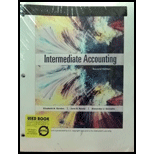
Concept explainers
Change in Accounting Principle, Inventory. Winthur Stores began operations on January 1, 2014, and adopted the FIFO method of accounting for its inventory for book and tax purposes In 2017, it is considering a change to the average-cost method basis for book purposes only. Winthur provided the following information to assist in deciding whether to change
| Ending Inventory | Cost of Sales | |||||
| Year Ended | FIFO | Average Cost |
FIFO | Average Cost |
FIFO | Average Cost |
| 12/31/2014 | $12,000 | $10,000 | $74,000 | $ 76,000 | $ 24,600 | $23,400 |
| 12/31/2015 | 19,500 | 16,000 | 78,500 | 82,000 | 51,600 | 48,300 |
| 12/31/2016 | 28,000 | 24,000 | 91,000 | 95,000 | 78,000 | 72,300 |
| 12/31/2017 | 35,600 | 32,000 | 90,000 | 108,000 | 111,600 | 95,100 |
Winthur Stores reported the following income statement information:
| Account | 2017 | 2016 | 2015 | 2014 |
| Sales revenue | $200,000 | $175,000 | $160,000 | $145,000 |
| Selling, general, and administrative expenses | $54,000 | $40,000 | $36,500 | $30,000 |
| Income tax rate | 40% | 40% | 40% | 40% |
Required
- a. Prepare the income statements under both methods for the years ended December 31, 2014, through December 31, 2016.
- b. Assume that Winthur Stores changes to the average-cost method effective January 1, 2017. Prepare the comparative income statements for the 3 years ended December 31, 2017.
- c. Prepare the retained earnings column of the statement of stockholders’ equity for the year ended December 31, 2017, assuming that Winthur does not present comparative statements Winthur does not declare dividends in 2014-2017.
Want to see the full answer?
Check out a sample textbook solution
Chapter 21 Solutions
Intermediate Accounting, Student Value Edition (2nd Edition)
Additional Business Textbook Solutions
Intermediate Accounting (2nd Edition)
Engineering Economy (17th Edition)
Financial Accounting, Student Value Edition (5th Edition)
Operations Management: Processes and Supply Chains (12th Edition) (What's New in Operations Management)
Principles of Microeconomics (MindTap Course List)
Horngren's Cost Accounting: A Managerial Emphasis (16th Edition)
- Can you help me solve this general accounting question using valid accounting techniques?arrow_forwardCan you solve this general accounting question with accurate accounting calculations?arrow_forwardI am looking for the correct answer to this general accounting problem using valid accounting standards.arrow_forward
- I am searching for the accurate solution to this general accounting problem with the right approach.arrow_forwardCan you solve this general accounting problem with appropriate steps and explanations?arrow_forwardPlease explain the solution to this general accounting problem using the correct accounting principles.arrow_forward
 Intermediate Accounting: Reporting And AnalysisAccountingISBN:9781337788281Author:James M. Wahlen, Jefferson P. Jones, Donald PagachPublisher:Cengage Learning
Intermediate Accounting: Reporting And AnalysisAccountingISBN:9781337788281Author:James M. Wahlen, Jefferson P. Jones, Donald PagachPublisher:Cengage Learning Cornerstones of Financial AccountingAccountingISBN:9781337690881Author:Jay Rich, Jeff JonesPublisher:Cengage Learning
Cornerstones of Financial AccountingAccountingISBN:9781337690881Author:Jay Rich, Jeff JonesPublisher:Cengage Learning Financial Accounting: The Impact on Decision Make...AccountingISBN:9781305654174Author:Gary A. Porter, Curtis L. NortonPublisher:Cengage Learning
Financial Accounting: The Impact on Decision Make...AccountingISBN:9781305654174Author:Gary A. Porter, Curtis L. NortonPublisher:Cengage Learning- Principles of Accounting Volume 1AccountingISBN:9781947172685Author:OpenStaxPublisher:OpenStax College
 Financial AccountingAccountingISBN:9781337272124Author:Carl Warren, James M. Reeve, Jonathan DuchacPublisher:Cengage Learning
Financial AccountingAccountingISBN:9781337272124Author:Carl Warren, James M. Reeve, Jonathan DuchacPublisher:Cengage Learning





